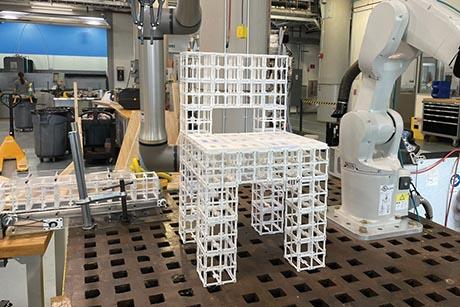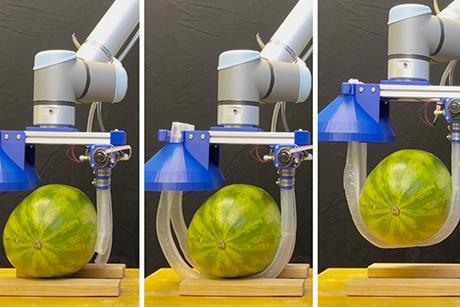Making data-informed Covid-19 testing plans
Warehouses, manufacturing floors, offices, schools — organizations of all kinds have had to change their operations to adapt to life in a pandemic. By now, there is confidence in some ways to help mitigate Covid-19 spread: contact tracing, distancing and quarantining, ventilation, mask wearing. And there is one scientific tool that can play a critical role: testing.
Implementing testing within an organization raises a number of questions. Who should be tested? How often? How do other mitigation efforts impact testing need? How much will it all cost? A new web-based Covid-19 testing impact calculator at WhenToTest.org has been developed by MIT researchers with the Institute for Data, Systems, and Society (IDSS), in collaboration with the Consortia for Improving Medicine with Innovation and Technology (CIMIT), to help organizations around the world answer these questions.
“The calculator allows you to do a cost analysis of different trade-offs and enables rational decisions for deploying testing within an organization,” explains Anette “Peko” Hosoi, a professor of mechanical engineering and IDSS affiliate who co-developed the tool. “How much does wearing masks save me? How much does contact tracing save me? How much testing do I have to do if I can’t social distance?”
The web calculator accepts four basic inputs: size of the organization, the percentage of those people who reliably wear masks, whether or not contact tracing is being employed, and the maximum number of people who interact closely without masks. There are also fields for cost considerations, since many organizations will pay to have testing conducted while also paying employees while they are being tested. With this information, the model provides two key estimates: how many people to test daily, and the weekly cost of that testing.
By adjusting the input to these questions, organizational decision-makers can explore these trade-offs, such as increasing mask use and decreasing group size to meet tighter testing budgets. The tool also estimates how much testing should be conducted in situations where masks or distance aren’t possible.
“The powerful thing about this tool is that we are not telling people what to do,” says Hosoi. “We are giving them information that empowers them to make rational, financial decisions that are tailored to their organization.”
Isolat’s impact
The model behind the website began as a project of the IDSS Covid-19 Collaboration called “Isolat,” a volunteer group of researchers at IDSS, MIT, and beyond who apply advanced statistical tools to Covid-19 data in order to help inform pandemic policy.
“The IDSS community came together and formed Isolat to address difficult questions that emerged from this pandemic,” says Munther Dahleh, a professor of electrical engineering and computer science who directs IDSS. “It brought together expertise in data science, in systems, in control theory, in fluid mechanics and fluid dynamics, because this problem is very broad. And it paid off.”
Isolat research produced a number of tangible impacts, informing not only MIT’s reopening and testing strategy, but also helping the state of Massachusetts establish guidelines for all its colleges and universities. The group built connections and provided insights to organizations in countries like India and Peru. It wasn’t long before Isolat research began to draw the attention of other groups working to solve pandemic challenges.
“After we developed the model, a number of organizations reached out to us, including RADx,” says Hosoi. RADx is the Rapid Acceleration of Diagnostics, an NIH-funded initiative to accelerate Covid-19 testing technology. This led to the larger collaboration with CIMIT, a network of academic and medical institutions including Massachusetts General Hospital that partners with industry and government to accelerate the development of innovative health-care technologies. With additional support and funding from the National Institute for Biomedical Imaging and Bioengineering, the model — which once lived in a spreadsheet — was developed into a user-friendly website where organizations of all kinds can get actionable advice on implementing Covid-19 testing.
“While test-technology development has been the main objective of RADx Tech, the program supports commercialization and deployment. The calculator is a major enabler for those activities,” says Paul Tessier, the tool’s co-developer and product development director at CIMIT. “We are excited to join forces with MIT’s IDSS to advance the calculator.”
Testing = control
The calculator can’t prevent all members of an organization from getting sick. But it can inform a testing plan that finds infected people and quarantines them more quickly, preventing further spread. Says Dahleh: “Testing is really the only mechanism for controlling a pandemic when you don’t have a vaccine. It’s testing, quarantining, and contact tracing that allow you to isolate infected people before they infect others.”
Isolat’s recommendations for testing were first published as a series of “rules of thumb” for reopening the MIT campus. The first rule: Testing equals control. Covid testing data can do more than help researchers and medical practitioners understand the extent of Covid-19 spread, or predict peaks in contagion and hotspot locations. A well-designed strategy that combines testing and other mitigation efforts can prevent sickness and even death.
The Covid-19 Testing Impact Calculator offers advanced options, allowing variables such as mask and contact tracing efficiency to be adjusted and modeling either typical (U.S. average) conditions or hotspot conditions when infections are spreading quickly. The site also provides a cost/benefit analysis of different testing methods and advice on how institutions should handle positive results.
“We’ve built a tool that we think can really help businesses, schools, and all kinds of organizations to navigate some of the challenges of the coronavirus pandemic,” says Dahleh. “We’re excited to share it, to refine it as we get feedback and new data, and ultimately to see what impact it will have.”


